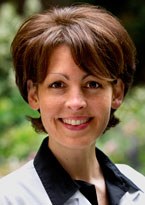Understanding women's heart disease
 BeWell asked Dr. Jennifer Tremmel, Clinical Director of Women’s Heart Health at Stanford, to explain what women should know about their heart disease risks and realities.
BeWell asked Dr. Jennifer Tremmel, Clinical Director of Women’s Heart Health at Stanford, to explain what women should know about their heart disease risks and realities.
What is the biggest misconception about heart disease?
The biggest misconception is not that it’s a man’s disease, because it very much is, but that it’s not a woman’s disease. Heart disease is the number one killer of both women and men, so it should be everyone’s concern.
When many people visualize a heart attack, they imagine an older man clutching his chest and dropping to the ground. Is there anything wrong with this image?
No. This image developed because that’s what a heart attack often looks like. The problem is that a heart attack can also look like a put-together middle-aged woman having tightness in her chest and shortness of breath while running a business meeting. We need to remember that, too.
We have this image of men because more men die of coronary heart disease than women. However, ultimately more women die of all forms of cardiovascular disease than men. One out of every four women will die of coronary artery disease (one out of two will die of cardiovascular disease). If you want to know what heart disease looks like, look at 25% of the women you know.
So, a woman’s heart attack could look very different from a man's . . .
There are several differences between women and men when it comes to a heart attack. In general, women will report some form of chest discomfort most often, just like men, but they often have a longer list of other complaints, including difficulty breathing, fatigue, or pain in the neck or back. This can confuse them and their doctor, particularly if both have the misconception that heart disease isn’t a woman’s disease. This leads to delays in women seeking treatment and delays in physicians providing care. Women tend to be older and sicker when they come in, are more likely to have complications during their procedures, and are more likely to die from their heart attacks. Because of all of these points, we need to approach women differently. When we do so, our goal is to narrow these gaps between women and men.
Knowing that women are at greater risk than they may realize, what should they do to protect themselves?
First of all, women need to know their risk factors. Second, they need to do something about them — which applies to men, as well. Most of the risk factors for heart disease are modifiable, so people have to take the initiative to change. Health care providers can give you guidance regarding diet, exercise, and weight loss, but only you can make it happen. Some medications may also be needed. However, the more someone does to improve their lifestyle, the less they will need medication. It’s really up to you.
And it should be noted that prevention continues even if you are diagnosed with heart disease. There is no one for whom a heart-healthy lifestyle isn’t indicated.
Finally, any parting words of advice for women at Stanford?
Well, I can tell women (and men) at Stanford that they have some of the best cardiac care in the world right at their doorstep. At Stanford, we pride ourselves on understanding sex differences and applying that to our research, teaching, and clinical care. Take good care of yourself, but if you ever need us, we’re right here.
Interview conducted by Julie Croteau
